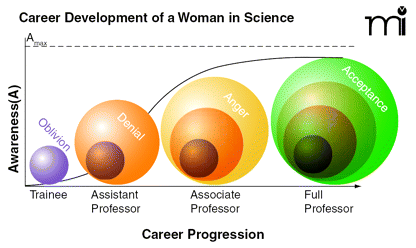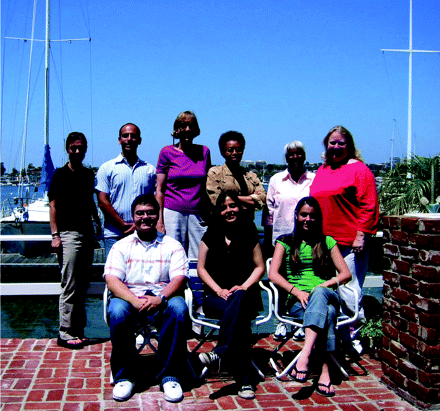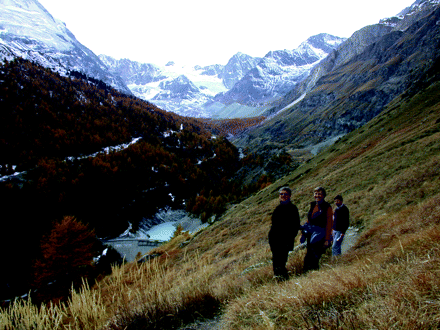A Career in Pharmacology: In Search of Beauty and Joy
Abstract
Sue Piper Duckles received her BA from UC Berkeley and her PhD from UC San Francisco, followed by postdoctoral work at UCLA. She rose through tenure appointments at UCLA Medical School and University of Arizona School of Medicine before arriving at the School of Medicine, University of California, Irvine, where she remains today with a dual appointment as Professor of Pharmacology and Associate Dean for Faculty Development. Her outstanding research career and her unparalleled devotion to the teaching and discipline of pharmacology are recognized with this year’s bestowal of the 2007 Sollmann Award for Career Achievement from ASPET1.
In her research role, Duckles has investigated how various elements of the blood vessel wall—endothelial cells, smooth muscle cells, and nerves—interact to control vessel caliber. Her work has elucidated unique characteristics of cerebral blood vessels, encompassing the impact of gonadal steroids and aging on vascular function. In her role as Associate Dean for Faculty Development, she has developed innovative, high-impact programs to support the career development of young faculty. A gifted leader, she has advocated for pharmacology at both the national and international levels, serving in various leadership roles, including: President of ASPET; Vice President for Science Policy for FASEB; and Secretary General of IUPHAR. She is currently President of the International Union of Basic and Clinical Pharmacology. In addition to the Sollmann Award, the 2007 Award in Excellence in Pharmacology and Toxicology was conferred upon Duckles by the Pharmaceutical Research and Manufacturers of America Foundation. She has indelibly marked and advanced each of the institutions she has touched, and her keen insight and generosity continue to do honor to the discipline of pharmacology. Here, Sue Duckles describes her approach to science as a reflection of a life spent in exploration and discovery.
In Search of Beauty and Joy
The search for beauty and joy seems to me an apt description of the life of a scientist: a life of discovery, including discovery within one’s scientific discipline, discovery of the natural world beyond one’s discipline, and self-discovery. One of the great privileges of a career in science is the opportunity to live at the frontiers of knowledge and to contribute, even in a small way, to moving those frontiers forward. For me, the moment of discovery is best exemplified by the sense of joy and beauty experienced during exploration of the natural world. Anyone who has ever climbed to the top of a peak to find a breathtaking view of the other side or hiked up a narrow canyon in a desert landscape to find a hidden and surprisingly beautiful waterfall will recognize the beauty and joy of scientific discovery. As participants in scientific exploration, we are incredibly privileged—the surprises inevitably continue as long as there is unexplored territory!
View to the west from the top of the “Gray Wall,” Crystal Range, Sierra Nevada, California. Photograph by Sue Duckles.
Family—Early Exploration

Receiving a career achievement award such as the Sollmann Award is a wonderful opportunity for self-reflection. For me, this starts with my family. I was born in Oakland, California, in 1946, to Joan and Carl Piper. My parents were hard-working and incredibly devoted to their family. We were surrounded by a loving, extended family of grandparents, great-grandmothers, great-aunts, and lots of cousins. Our world was circumscribed geographically, but it was also enormously diverse, as we lived in proximity to San Francisco, in a railroad terminus and port city filled with people from all over the world. I was the second of three daughters born in quick succession just after World War II. Ultimately, my parents had five daughters, with fourteen years between the youngest and oldest. Our home was adjacent to an enormous regional park, which seemed to me an incredible wilderness of redwood canyons, oak-studded hills, and wildflower-filled grasslands. As a child, every summer vacation was a camping experience somewhere in California. These early experiences of exploration surely fueled my intellectual curiosity as well as my love of biology.
Training and Discovery: Academic Beginnings
In 1963, I entered the University of California, Berkeley. This was a time of tremendous social ferment and change in the United States, and in many respects, Berkeley and San Francisco were the incubators. In the first semester of my freshman year, John F. Kennedy was assassinated; in my sophomore year, the infamous Free Speech Movement began, followed by a series of sit-ins and political debates, morphing into protests against the Vietnam War. Next came the so-called Summer of Love and the subsequent Hippie era. All of this swirled around me as I completed my bachelor’s degree at UC Berkeley (majoring in philosophy) and then entered UC San Francisco to pursue doctoral work in pharmacology.
One of the major life-changing events of this period was meeting my husband, Larry Duckles. Larry’s musical talent, extensive knowledge of history, and experiences in Europe opened another side of life that I had not really known. We also share a love of the outdoors, adventure, and California landscapes. In 2008, we will celebrate our fortieth wedding anniversary with our two favorite sons, Ian and Galen Duckles. It is impossible to overstate the importance of having a truly supportive partner who genuinely takes pride in all of my accomplishments.
Another very important person in my early academic life was Thomas F. Burks, who chaired the department of pharmacology at the University of Arizona School of Medicine. Tom was the ultimate mentor, providing unswerving and daily support to every assistant professor in his department. I owe Tom an enormous debt of gratitude, which I try to repay, in honor of his example and untimely death, by mentoring others.
Rising above the Gathering Storm: Being a Woman in Science
In thinking about experiences as a woman in science, the image that came to mind was a picture, taken on my recent trip to Antarctica of a developing storm. In an interesting coincidence of thought, I was intrigued to learn later that this same imagery inspired the title of a recent report on women in science, Rising above the Gathering Storm (1). Indeed, as increasing numbers of women and minorities continue to embark on science careers, it is all the more tempting to point to successful women and minority scientists as evidence that we in science have successfully weathered the storm of inequality. After all, if these women can make it, so the argument goes, surely our methods of review and evaluation have become objective and merit-based. But in spite of the growing diversity among those entering science, disparities stubbornly persist between the advancement of majority men on the one hand and women and members of underrepresented minority groups on the other.
For a long time, many women in science (and perhaps other professions as well) have been unwilling to discuss issues of disparity for fear of alienating male colleagues and being typecast as “feminists.” Hopefully, young people today will benefit from easier, more equalized access to information as they embark on the careers they choose, so that a discussion of disparity will have no practical significance or associated fear. But in my own experience, four types of coping mechanisms have been useful. The first is to be oblivious, which is relatively easy early in one’s career, when evaluation is based primarily on grades, and hard-working students of any stripe are valued in the laboratory. As one advances, however, it is harder and harder to remain oblivious, and a sort of willful ignorance can facilitate a certain degree of functioning. Eventually, the blinders that are put on begin to chafe, leading some women to become angry and to begin thinking and speaking about their experiences. In most cases, this anger is followed by some degree of acceptance, perhaps including a commitment to work for change. But no matter how far one progresses, the continuum of coping mechanisms remains present and must be traversed continually. Each mechanism is essential. We cannot help but be simultaneously oblivious, working to ignore, angry, and accepting.

The issues of disparity that confront us in science have been summarized very well by a panel of experts organized by the National Academy of Science and chaired by Donna Shalala (2). First, it is clear that women face discrimination in every field of science. Another important aspect is the understanding of cultural biases that are implicitly held by everyone, men as well as women. A third point is that evaluation criteria contain arbitrary and subjective components that disadvantage women. Finally, long-standing academic structures and rules contribute significantly to the underutilization of women.
The impact of cultural biases has been highlighted in a Swedish study of the review process for granting postdoctoral fellowships (3). This study showed that women had to be more than twice as productive as men to be judged equally competent. A second study examined recommendation letters for successful faculty candidates at medical schools in the United States (4). Even among this pool of successful candidates, gender stereotyping systematically resulted in women candidates receiving less favorable recommendations. For example, letters written for men candidates were longer and more likely to stress publication record and curriculum vitae, whereas letters for women were more likely to discuss aspects of personal life.
What’s a Woman to Do?*
-
Develop a circle of advisors.
-
Educate yourself.
-
Use the power you have.
-
Be strategic in the choices you make.
-
Become successful outside your institution.
-
Be effective in influencing decisions.
-
Learn to negotiate.
-
Know it isn’t always about you.
-
Don’t give up!!!
* With help from Virginia Valian’s Why So Slow? [See (22).]
Maxine Singer recently summarized gender bias in Science magazine (5). Referring to the concept of microinequities, she observes, “Even seemingly minor, inadvertent exclusions…add up to serious discouragement for women.” It seems to me impossible, even undesirable, to “fix” gender differences. But as we all become more aware of these issues, and if the under-represented especially understand that the biases they face do not reflect a lack of competence, then it seems that the road should become a little easier. Despite some stormy weather, there are still wonderful opportunities in a scientific career.
The Beauty of Discovery: Estrogen and Mitochondria
No matter how long one’s research career, the opportunity to find something beautiful in an out-of-the-way corner is always present. Thus, it was with great excitement that we recently discovered a profound effect of estrogen on the function of cerebrovascular mitochondria [(6); see also (7)]. Mitochondria function in some ways as autonomous organelles within the cell, multiplying and dividing as metabolic demands change or cells grow and divide (8). Strikingly, mitochondrial DNA encodes only thirteen proteins involved in respiratory function; all other proteins essential for mitochondrial function are encoded by the cell nucleus. Thus, there must be an exquisitely tuned mechanism for coordinating the production of mitochondrial proteins encoded by nuclear and mitochondrial DNA. Little is known about this coordination, although information on some of the transcription factors involved is rapidly emerging.
The major function of the mitochondrion is the conversion of dietary fuel into cellular energy (ATP). The tricarboxylic acid cycle (TCA), the electron transport chain, and ATP synthase orchestrate the process of mitochondrial oxidative phosphorylation, which has been likened to a factory assembly line. Just like any factory, oxidative phosphorylation inevitably produces by-products, which in this case take the form of reactive oxygen species (ROS). ROS can oxidize lipids, proteins, and DNA within the mitochondrion.
Because mitochondrial DNA is poorly protected and repair mechanisms are limited, damage to mitochondrial DNA accumulates over time, the recognition of which has led to the mitochondrial theory of aging. This theory posits that accumulation of mitochondrial DNA mutations, which correlates with the metabolic rates of active tissues, ultimately leads to dysfunction and development of age-related disease (8). Interestingly, the one intervention best known to prolong lifespan in mammals, caloric restriction (9), has predictable effects on mitochondrial ROS production. By decreasing the rate of oxidative phosphorylation and thus the rate of ROS production, decreased caloric intake would accordingly prolong lifespan.
Effect of Estrogen on Mitochondrial Function
We have recently found that estrogen treatment promotes mitochondrial efficiency in the cerebral vasculature, increasing oxidative phosphorylation while at the same time decreasing mitochondrial ROS production (6, 10). Cerebral blood vessels are important constituents of the blood–brain barrier and regulate the transport of many essential substances into and out of the brain (11). In fact, cerebral endothelial cells are more metabolically active than endothelial cells in any other vascular bed, making this tissue particularly interesting for investigation of mitochondrial function. Indeed, loss of mitochondrial function in cerebral blood vessels could be an important contributor to a variety of age-related brain diseases, including Alzheimer’s, other forms of dementia, and stroke.
We have shown that treatment of ovariectomized female rats with 17β-estradiol increases the activities of both mitochondrial citrate synthase (the rate-limiting enzyme of the TCA) as well as complex IV (the rate-limiting element of electron transport) in cerebral blood vessels. Levels of other key mitochondrial proteins (i.e., subunits I and IV of complex IV and cytochrome c) are also elevated after estrogen treatment. In vitro treatment with ICI-182,780, an estrogen receptor antagonist, inhibits the ability of 17β-estradiol to increase cytochrome c activity. This result follows our earlier demonstration that 17β-estradiol, administered either in vivo or in vitro, upregulates the PI-3 kinase/Akt pathway in cerebral blood vessels (12); however, inhibitor studies suggest that the effect of 17β-estradiol on cytochrome c is not mediated by the PI-3 kinase/Akt pathway.
Given that estrogen treatment facilitates oxidative phosphorylation, one might expect that mitochondrial superoxide production and mitochondrial oxidative stress would increase. Remarkably, this expectation is directly contradicted in our studies. For example, mitochondrial levels of hydrogen peroxide, a metabolite of the manganese-dependent superoxide dismutase (MnSOD) that is unique to the organelle, are decreased in cerebral blood vessels after four weeks of 17β-estradiol treatment (6). Similarly, mitochondrial superoxide levels, which can be measured by a light-emitting indicator that partitions into mitochondria, decrease in human brain microvascular endothelial cells treated with 17β-estradiol (7, 13). This result corroborates the observed drop in levels of hydrogen peroxide, which is a metabolite of superoxide.
Mitochondria are a major source of superoxide, especially in metabolically active cells such as cerebral endothelial cells, and we know that production of superoxide by mitochondria can contribute to vascular pathophysiology and endothelial dysfunction by a variety of mechanisms (14). Among these, the accumulation of irreversible damage to mitochondrial DNA over time may be key. The ramifications of estrogen-mediated decreases in mitochondrial ROS production may thus be important in the clinical context. Specifically, the benefits of estrogen treatment in this respect would likely be protective, rather than curative. If estrogen is not present for a period of time, for example in women after the menopause, then ROS production would be predicted to increase, causing irreversible mitochondrial DNA damage. Subsequent treatment with estrogen would not be expected to reverse post-menopausal symptoms that reflect the demise of mitochondria in cells previously deprived of estrogen.
Members of the Duckles/Krause laboratory (2006): Rayna Gonzales, Ali Razmara, Sue Duckles, Lorraine Sunday, Jonnie Stevens, Diana Krause (left to right, back row), Carlos Silva, Bebe Ershan, Christa Osuna (front row).
The role of estrogen in maintaining mitochondrial efficiency may have important implications for cardiovascular health in general, as well as for the interpretation of recent large clinical trials (15–17) that failed to show positive cardiovascular effects in response to hormone replacement. In fact, hormone treatment may actually have caused an increase in the incidence of heart disease and stroke (18). One concern about the methodology of the Women’s Health Initiative Study is that the subjects were more than ten years past the age of menopause, with an average age of sixty-three years at the initial screening (19, 20). Indeed, a recent re-evaluation of these trials suggests that women who start hormone therapy within ten years of menopause may have less risk of heart attack than women who begin hormone therapy at a later point (20). If the capacity of estrogen to limit ROS production and thereby prevent DNA damage in mitochondria contributes to the cardiovascular protective effects of the hormone, the lack of efficacy of estrogen in the Women’s Health Initiative Study may well suggest that hormone treatment was initiated too late after menopause to elicit a therapeutic effect. Indeed, an additional study, the Kronos Early Estrogen Prevention Study (KEEPS), started in 2005, is designed to assess surrogate end points for atherosclerosis soon after the onset of menopause (19).
While studies of hormone replacement therapy for the prevention of cardiovascular disease and stroke remain surrounded by controversy, evidence continues to emerge that ovarian hormones increase the human life span. A recent study of women who had undergone hysterectomy for benign disease (21) compared women who retained their ovaries with women who were ovariectomized at the time of hysterectomy. The loss of ovaries before the age of fifty-five years is associated with an increase in mortality (8.6%) that is apparent within twenty-five years after operation. In addition, the age of the subject at the time of ovariectomy is directly proportional to the effect on mortality. Thus, retention of ovaries until the age of 65 or longer significantly increased long-term survival. As discussed above, accumulation of mitochondrial DNA mutations as a consequence of mitochondrial superoxide production is thought to contribute to aging. The hypothesis that estrogen prolongs life by decreasing rates of mitochondrial ROS production is very intriguing. It is always a great moment when a bright student asks, “Is this why women live longer than men?”
Collaboration and Enlightenment
The wonderful colleagues and friends one makes all around the world are another great pleasure of being a biomedical scientist. Scientists who visit foreign countries are not just tourists, but honored friends, and these friendships truly enhance one’s appreciation of the world. Seeing another country through the eyes of a colleague and friend makes it possible, even if only to a small degree, to better understand life in another culture. And whether our collaborations are international or with compatriots, there is a distinct joy of working with wonderful people in the laboratory setting. I have been particularly blessed with outstanding collaborators as well as with committed postdoctoral fellows and students. Having a laboratory family is another very special privilege of being a pharmacologist.
Fiat Lux!
Two final images sum up my feelings about life as a pharmacologist. Both are about light, and how different types of light show us beauty in different ways. I still remember, as I first arrived at UC Berkeley with my fellow incoming students, how I was inspired by the Chancellor as he addressed us and explained the motto of the University of California: “Fiat lux. Let there be light.” I believe strongly in this precept as the role of education and the role of Science—to shed light in dark corners and empower all who pursue knowledge. How can anyone be more privileged than to participate actively in such an effort?
Footnotes
-
↵1 The Sollmann Award for Career Achievement from the American Society for Pharmacology and Experimental Therapeutics was established by Wyeth Research to commemorate the pioneering work of Torald Sollmann in the fields of pharmacological investigation and education in the United States and to acknowledge the recipient’s career-long excellence in these endeavors. The essay presented here is based on Professor Duckles’s acceptance speech upon receiving the Award at Experimental Biology 2007 in Washington DC. For a recent discussion of Torald Sollmann and his work, see (23).
- © American Society for Pharmacology and Experimental Theraputics 2007
References

Relationship of mitochondrial reactive oxygen species (ROS) production and cellular aging. ROS, produced as a by-product of mitochondrial oxidative phosphorylation (OXPHOS), mutate mitochondrial DNA (mtDNA). These mtDNA mutations accumulate over time in metabolically active cells, ultimately leading to mitochondrial and cellular dysfunction manifested as aging. Adapted from a figure by Ali Razmara.













